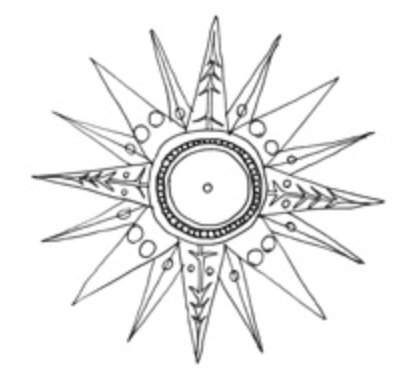*For a simple and efficient tool to help you find harmonics and multiphonics, download the new CELLO MAP APP
Harmonics are produced when the plucked/struck/bowed string is touched at particular points with light finger pressure. The string vibrates on both sides of the touching finger. The pitches of the harmonics correspond to each partial of the open string; the first harmonic is the string’s fundamental. The points on the open string at which harmonics are generated lie at the nodes of each ascending partial (i.e., where the string is divided by a whole number, e.g., 1/2; 1/3, 2/3; 1/4, 2/4, 3/4; 1/5, 2/5, 3/5, 4/5…). A harmonic can be produced at several of its nodal points, for example the third harmonic is obtainable by touching the string at 1/3 and 2/3 of its length. However a harmonic is not necessarily found at all of its associated nodes, for example the fourth harmonic is obtainable at 1/4 and 3/4 of the string length but not at 2/4. I will refer to the nodal points on the string at which a particular harmonic can be produced as ‘touch points’ for that harmonic, i.e., the set of ‘touch points’ for a harmonic is a subset of its nodal points. In other words a touch point is always a nodal point but the reverse is not true. Finding alternative touch points for a particular harmonic and knowing how many equivalent touch points are available can be useful to cellists in minimising shifts in the left hand, especially in fast passages.
Harmonics become quieter, more difficult to control (it is more difficult to find their position, they are more sensitive to changes in bow pressure and speed) and less overtone-rich as they ascend. Harmonics are most overtone-rich on the A string, and are increasingly less overtone rich on the thicker and stiffer D-, G- and C-strings.
The sound quality of harmonics is characterised by their weak overtone content relative to equivalent pitches on the stopped string. The first harmonic, the open string, is the only exception to this, having a very rich overtone content. However, harmonics become overtone-weaker as they ascend. The reduction in higher partials is significant at first and gradually becomes marginal. This reduction can be expressed in the harmonic sequence: 1/1, 1/2, 1/3, 1/4,1/5…1/n, i.e., the fundamental (first harmonic) has the ‘maximum’ number of overtones, the second harmonic has half as many as the first, the third harmonic has a third of the amount of the first etc.,
▶︎HOW HARMONICS WORK
Touching the string (without pressing it to the fingerboard) fixes the area under the finger as a static point during vibration. Partials with antinodes at this point are unable to vibrate under these conditions and partials with nodes at this point are free to vibrate.
The second harmonic is produced by touching the string at its mid point, an antinode for all of the odd partials. The odd partials are ‘blocked’ from the sound. The overtone content is halved since only the even partials (that is every other partial in the finite set of partials available in the open string) are able to vibrate. The new fundamental is the second partial of the open string (since the first partial has been excluded), the new second partial is the open string’s fourth partial, the new third partial is the open string’s sixth partial, etc.

Similarly, in touching the string at 1/3 or 2/3 of its length, the finger blocks partials with antinodes at, or close to, this point. All partials that have orders of a multiple of three are free to vibrate because they have a node at this point. Consequently, only every third partial sounds, the timbre contains a third of the number of overtones of the open string. The new tone’s fundamental is the open string’s third partial, the new second partial is the open string’s sixth partial, the new third partial is the open string’s ninth partial, etc.

So, the second harmonic contains half of the number of overtones of the open string, the third harmonic contains a third of the number of overtones of the open string, the fourth harmonic contains a quarter, the fifth a fifth, etc. This is true because there are a finite number of available partials on a cello string, limited by several factors including: string width relative to length, point of contact, exciter properties and cello body responses. These factors are flexible. Therefore, it is more accurate to say that the potential overtone content of a harmonic for various points of contact/excitation forces, etc., decreases as harmonic order increases.
▷IN CONTEXT
The reduced overtone content of harmonics in general means that they are particularly susceptible to damping; small increases (for example, using a slightly less dense plectrum) result in a relatively larger reduction in overtone content than for the stopped string. This is why cellists often use the fingernail for pizzicato harmonics. The exception to this rule is the first harmonic, the open string, which, is unrestricted by a touching or a stopping finger. The combined effect of this and the open string having the largest number of potential overtones means it can ring very ‘brightly’. The timbre can stand out as harsh compared to the stopped string. Cellists often avoid playing open strings because of this effect, preferring to stop a lower string at the same pitch
▶︎▶︎Note
In reality, the pattern of overtone reduction in ascending harmonics might be more complicated than the above description suggests. Partials might only be subdued rather than completely excluded from the sound or extra partials might be included because of responses from the cello body/room or in combinations of various other partials. Moreover, upper partials of the higher harmonics are restricted even further because the effects of damping at the touching finger, which are relatively larger for higher harmonics. However, despite this, the broad pattern is generally true.


